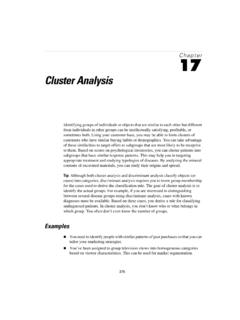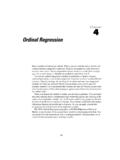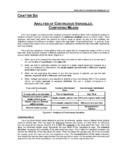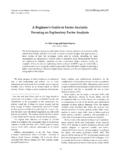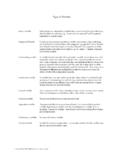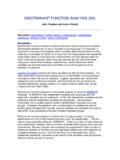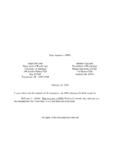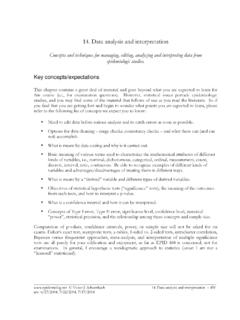Transcription of Cluster Analysis - norusis.com
1 Chapter 16. Cluster Analysis Identifying groups of individuals or objects that are similar to each other but different from individuals in other groups can be intellectually satisfying, profitable, or sometimes both. Using your customer base, you may be able to form clusters of customers who have similar buying habits or demographics. You can take advantage of these similarities to target offers to subgroups that are most likely to be receptive to them. Based on scores on psychological inventories, you can Cluster patients into subgroups that have similar response patterns. This may help you in targeting appropriate treatment and studying typologies of diseases.
2 By analyzing the mineral contents of excavated materials, you can study their origins and spread. Tip: Although both Cluster Analysis and discriminant Analysis classify objects (or cases) into categories, discriminant Analysis requires you to know group membership for the cases used to derive the classification rule. The goal of Cluster Analysis is to identify the actual groups. For example, if you are interested in distinguishing between several disease groups using discriminant Analysis , cases with known diagnoses must be available. Based on these cases, you derive a rule for classifying undiagnosed patients. In Cluster Analysis , you don't know who or what belongs in which group.
3 You often don't even know the number of groups. Examples You need to identify people with similar patterns of past purchases so that you can tailor your marketing strategies. 361. 362. Chapter 16. You've been assigned to group television shows into homogeneous categories based on viewer characteristics. This can be used for market segmentation. You want to Cluster skulls excavated from archaeological digs into the civilizations from which they originated. Various measurements of the skulls are available. You're trying to examine patients with a diagnosis of depression to determine if distinct subgroups can be identified, based on a symptom checklist and results from psychological tests.
4 In a Nutshell You start out with a number of cases and want to subdivide them into homogeneous groups. First, you choose the variables on which you want the groups to be similar. Next, you must decide whether to standardize the variables in some way so that they all contribute equally to the distance or similarity between cases. Finally, you have to decide which clustering procedure to use, based on the number of cases and types of variables that you want to use for forming clusters. For hierarchical clustering, you choose a statistic that quantifies how far apart (or similar) two cases are. Then you select a method for forming the groups. Because you can have as many clusters as you do cases (not a useful solution!)
5 , your last step is to determine how many clusters you need to represent your data. You do this by looking at how similar clusters are when you create additional clusters or collapse existing ones. In k-means clustering, you select the number of clusters you want. The algorithm iteratively estimates the Cluster means and assigns each case to the Cluster for which its distance to the Cluster mean is the smallest. In two-step clustering, to make large problems tractable, in the first step, cases are assigned to preclusters. In the second step, the preclusters are clustered using the hierarchical clustering algorithm. You can specify the number of clusters you want or let the algorithm decide based on preselected criteria.
6 Introduction The term Cluster Analysis does not identify a particular statistical method or model, as do discriminant Analysis , factor Analysis , and regression. You often don't have to make any assumptions about the underlying distribution of the data. Using Cluster Analysis , you can also form groups of related variables, similar to what you do in factor Analysis . There are numerous ways you can sort cases into groups. The choice of a method 363. Cluster Analy sis depends on, among other things, the size of the data file. Methods commonly used for small data sets are impractical for data files with thousands of cases. SPSS has three different procedures that can be used to Cluster data: hierarchical Cluster Analysis , k-means Cluster , and two-step Cluster .
7 They are all described in this chapter. If you have a large data file (even 1,000 cases is large for clustering) or a mixture of continuous and categorical variables, you should use the SPSS two-step procedure. If you have a small data set and want to easily examine solutions with increasing numbers of clusters, you may want to use hierarchical clustering. If you know how many clusters you want and you have a moderately sized data set, you can use k-means clustering. You'll Cluster three different sets of data using the three SPSS procedures. You'll use a hierarchical algorithm to Cluster figure-skating judges in the 2002 Olympic Games. You'll use k-means clustering to study the metal composition of Roman pottery.
8 Finally, you'll Cluster the participants in the 2002 General Social Survey, using a two-stage clustering algorithm. You'll find homogenous clusters based on education, age, income, gender, and region of the country. You'll see how Internet use and television viewing varies across the clusters. Hierarchical Clustering There are numerous ways in which clusters can be formed. Hierarchical clustering is one of the most straightforward methods. It can be either agglomerative or divisive. Agglomerative hierarchical clustering begins with every case being a Cluster unto itself. At successive steps, similar clusters are merged. The algorithm ends with everybody in one jolly, but useless, Cluster .
9 Divisive clustering starts with everybody in one Cluster and ends up with everyone in individual clusters. Obviously, neither the first step nor the last step is a worthwhile solution with either method. In agglomerative clustering, once a Cluster is formed, it cannot be split; it can only be combined with other clusters. Agglomerative hierarchical clustering doesn't let cases separate from clusters that they've joined. Once in a Cluster , always in that Cluster . To form clusters using a hierarchical Cluster Analysis , you must select: A criterion for determining similarity or distance between cases A criterion for determining which clusters are merged at successive steps The number of clusters you need to represent your data 364.
10 Chapter 16. Tip: There is no right or wrong answer as to how many clusters you need. It depends on what you're going to do with them. To find a good Cluster solution, you must look at the characteristics of the clusters at successive steps and decide when you have an interpretable solution or a solution that has a reasonable number of fairly homogeneous clusters. Figure-Skating Judges: The Example As an example of agglomerative hierarchical clustering, you'll look at the judging of pairs figure skating in the 2002 Olympics. Each of nine judges gave each of 20 pairs of skaters four scores: technical merit and artistry for both the short program and the long program.
